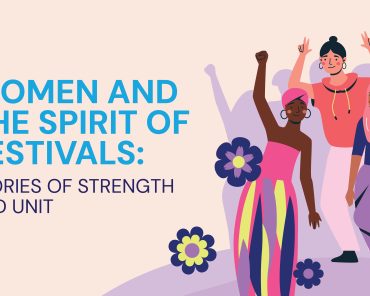By Ankita Purohit
What women should wear? Traditional or Western clothes?
This debate of what women should wear doesn’t seem to end and many people argue for their opinion without actually concluding anything. Some say that western clothes are more comfortable and one must change their mindset with time, others say that one must not forget her own traditional values. Many also argue that only traditional wear shows modesty and signifies that those women who symbolize that are decent, and others do not. Yet many families allow their girls to wear whatever they wish, many do not, and others have a set of limits that till only certain extent they are allowed. So, what’s the deal? What women should really consider wearing? Traditional or western outfits?

When we talk about the term ‘traditional’ it covers saree and salwar kameez. We see many foreigners happily wear the colorful Indian attire and Indian follow their pattern of clothing. The reason why Indian women like their dressing is because it represents the modern lifestyle and a sense that they are confident to face the world. This does not mean that traditional clothes have lost their value. Previously the women were confined to home only but now is the time that most of them go to offices and have to serve both workplace and home. Wearing saree practically every day is time consuming. And dupatta that is a part of salwar kameez is no less than a hurdle. There are chances that it might get stuck between the tyre of your or your husband’s two wheeler, creating an accident. This is the reason why formal dresses for women like trousers and shirt are in the current trend. Some would even argue that finely pin-up your dress will lessen your problems, but to what extent? Moreover, don’t you think it is time consuming? As per the Indian constitution, there is no mentioning of any specific type of dress code and so the current trends only decide what is in the norm. Women follow the fashion accordingly and also through mouth-to-mouth publicity.
“I never think about how other people will respond to the way I dress…”
If a woman wears anything it shows the surroundings where she currently resides, her opinions about the subject, confidence to carry whatever she chooses to wear, and indirectly her way of showing the world that to what extent looking good and be a fashionista matter to them. It is not always the case that they dress up for their husband or boyfriend. They wear for themselves too, to look good, to feel good! When someone argues about the Indian tradition probably he doesn’t possess much knowledge about the history of India. So, let us shed some light on the real facts.

History of clothing in India
 Back in the 300 B.C. women used to wear two-piece rectangular clothes that simply hid their crucial body parts, one at the lower region and other at the upper. During the 7th and 8th century when the Gupta dynasty ruled, stitched garments were the norm, that too in the upper and lower region. In the southern part of India, even during the colonial times there were many women who did not cover their upper body part. As per the hot climate it was acceptable back then. People simply followed what they thought was convenient to them.
Back in the 300 B.C. women used to wear two-piece rectangular clothes that simply hid their crucial body parts, one at the lower region and other at the upper. During the 7th and 8th century when the Gupta dynasty ruled, stitched garments were the norm, that too in the upper and lower region. In the southern part of India, even during the colonial times there were many women who did not cover their upper body part. As per the hot climate it was acceptable back then. People simply followed what they thought was convenient to them.
Throughout history, India was influenced with so many different cultures to which the pattern of clothing merged – Greeks, Arabs, Romans, Chinese and Britishers. Arabs visited India and ruled most part of it during 16th and 17th century. Since those people weren’t familiar with the Indian culture and obviously weren’t used to watching women with partially bare body they were the ones that imposed covering them up from head to toe in order to prevent them from getting ‘molested’ – The term which was not familiar by Indians. Parda Pratha then emerged and became a common practice. In this, the body was covered as a whole with a long cloth in which nothing was practically visible, not even a face! This is how saree came into existence.
Then came the Britishers, a.k.a the East India Company. Most Indians at present think that the West is ruling the mindset of youngsters and that the clothes like skirts, blouse, etc. are part of their culture and we must abolish that. On the other hand, sarees and salwar kameez must be the norm entirely since these make part of the Indian tradition, which is partially true.
 Salwar Kameez – the famous Indian attire is believed to have its roots among the Mughals, the Muslim rulers in India who came from Arab world. Previously due to religious differences Indian women hesitated wearing this outfit. Also traditionally all women were married around their puberty. So, previously they used to wear what children ought to and once they were settled to a new place, saree was the only option left with them. After a few decades there came a time when they started completing their graduation and weren’t married away during their childhood phase. The time frame in which they were unmarried adults and could not wear what other children did, they were left with wearing salwar kameez only since saree would be way too traditional and mature; and salwar kameez would also fulfill their demand of ‘modesty’.
Salwar Kameez – the famous Indian attire is believed to have its roots among the Mughals, the Muslim rulers in India who came from Arab world. Previously due to religious differences Indian women hesitated wearing this outfit. Also traditionally all women were married around their puberty. So, previously they used to wear what children ought to and once they were settled to a new place, saree was the only option left with them. After a few decades there came a time when they started completing their graduation and weren’t married away during their childhood phase. The time frame in which they were unmarried adults and could not wear what other children did, they were left with wearing salwar kameez only since saree would be way too traditional and mature; and salwar kameez would also fulfill their demand of ‘modesty’.
 Don’t you think ‘petticoat’ and ‘choli’ resemble the long skirt and blouse that British women used to wear during the British Raj? Once the wife of Satyendranath Tagore (brother of Rabindranath Tagore – The famous Bengali poet), Jnanadanandini Debi, was not allowed to enter a club because she wore the saree on her bare breasts; the result of which the family supported the idea of wearing the blouse for women. This is where the idea of three piece emerged – a choli, a lehenga or ghaghra, and a dupatta or saree. Every region in India has different names and a wide range of the methods of draping it but the concept is same. Saree rules the country, especially the rural region. The women of urbun area also wear that on some occasions or festivals.
Don’t you think ‘petticoat’ and ‘choli’ resemble the long skirt and blouse that British women used to wear during the British Raj? Once the wife of Satyendranath Tagore (brother of Rabindranath Tagore – The famous Bengali poet), Jnanadanandini Debi, was not allowed to enter a club because she wore the saree on her bare breasts; the result of which the family supported the idea of wearing the blouse for women. This is where the idea of three piece emerged – a choli, a lehenga or ghaghra, and a dupatta or saree. Every region in India has different names and a wide range of the methods of draping it but the concept is same. Saree rules the country, especially the rural region. The women of urbun area also wear that on some occasions or festivals.
I don’t think one must debate this topic without knowing the actual facts. As far as I think one must wear as per their own comfort, their level of confidence they carry with every clothing, and as per the occasion and environment. One will look practically awkward if they wear a saree at the beach side or a pair of shorts in a wedding ceremony! It is not that Indian girls do not value or like to follow the traditions. They do follow it occasionally, like during festivals and weddings. There is no denial that saree is one of the most beautiful outfits and most Indians, NRIs, and foreign women embrace it, but one must also understand that wearing it every day is difficult. So, let women decide on what occasion they are likely choosing what, based on their own comfort. Simple!






Praveen Mishra
May 5, 2017
Western dresses looks are really awesome that’s why women and girls wear western dresses. awesome information thank you for sharing
alex hilton
May 5, 2017
Great post. You can also visit http://www.lsmfabrics.com/ that has an ever-changing and ever-growing collection. Their prices are reasonable and styles are always on trend.
Manish Manral
May 9, 2017
Saree and western dresses are winning million of hearts in India, girls and women’s are crazy about these outfits. its depend on choice of a women that what kind of dress she should wear.
replica watches india
June 21, 2017
You always provide quality based posts, enjoy reading your work.
Ravi S
August 10, 2017
nice information thanks for sharing very use ful
swati singh
August 22, 2017
Hello Admin
Your blog is very nice & informative. Thanks for sharing with Us, Great post. Keep posting
Mydesiwear
October 13, 2017
very interesting article on good topic.. very well explained both the sides thanx for sharing it with us
Bombaybuy
January 23, 2018
One must wear as per their own comfort
aadila
February 5, 2018
“Thanks for sharing, Keep bringing more!!
Have a good one ahead!
Greetings from India”
Aarti
February 9, 2018
Not traditional, nor Western, It’s high time for INDO-WESTERN!
ravi
March 21, 2018
wow really nice blog thanks for sharing very use ful
Ladies Western Wear in Nagpur
March 21, 2018
Thanks for sharing such useful information. India is country with different tradition but also adopt the western culture.
siya
March 23, 2018
nice.. i am spending a lot of time on the internet but i cannot find content like yours.Thanks and keep us update
Ladies Wear Suppliers in Nagpur
April 5, 2018
In India, there is the great importance of traditional. On every occasion, Indian ladies wear traditional outfits rather than western. Here is also a craze for western wear.
Western wear
April 6, 2018
It’s so nice. Great blog.
Indian kurtis online
April 6, 2018
Nice article! I Ethnic wears are always the first choice for a traditional function or occasion for almost all women across the world. Foreign people blossoms in blushing and colorful traditional Indian outfits also get attracted by this desi outfits and spotted wearing Indian ethnic wear. Even Hollywood celebrities love wearing Indian ethnic wears.
Rajni
April 25, 2018
Very nice information
siya
May 7, 2018
Wow. there is no doubt that you are a good writer. your site has nice content .eAlpha.com
Western wear
May 24, 2018
Great collection. Keep sharing..!!
Western wear
June 12, 2018
Nice and unique collection. thanks for sharing..!!
rohit aggarwal
August 30, 2018
thanks for sharing keep it up
Dhira singh jain
April 20, 2019
i read your post but there are some truth missing from history of islam and arab,when arab first came in india and saw the beauty indian woman they were started rape and molestation ind hindu/indian women at very large scale,before that a dress named as Angiya is in india attire was in tradition,and by the way why did you forgot about Mahabharat Or Ramayan.in those era there are no half bare indian women by record of vedas.
any criticism would be appreciated.
thank you.
Ankita Purohit
April 22, 2019
Hi,
The blog is based on the research that I had done back in 2016 that mentions the evolution of the dress code of women in India in neutral tone with key details. About the detailing part, whole India contained a lot of different cultures. For instance, just like you mentioned about Angiya, South Indian women too would wear Mund. Many of them still wear it. Moreover, I didn’t get the Ramayan/Mahabharat part in my research that time, else I would have mentioned that as well. I will update this part if I get enough of it.
Thanks for your feedback.
Deepika
June 13, 2019
I totally agree with you. There is no point arguing on this topic. Ethnic wear and western both have there own specialty. We cant judge. So, forget everything and wear what makes you feel happy 🙂
laropas
July 4, 2019
Thank you for providing nice information.
Hemal Tejani
July 27, 2019
I think Women’should wear Traditional wears as they bring out the gorgeous feminine charm in a women.
Anamika
September 16, 2019
I don’t really know why other Asian women do not wear traditional clothing, but the trend of traditional clothing only for women as a standard for daily wear and even office wear is pretty special to India.